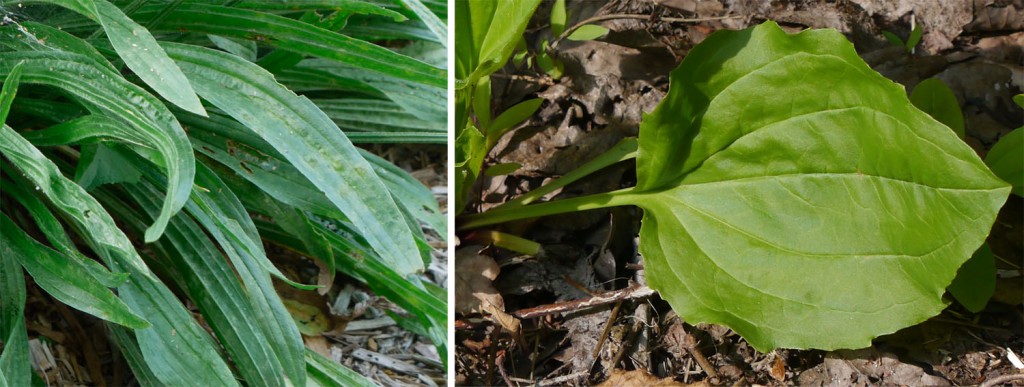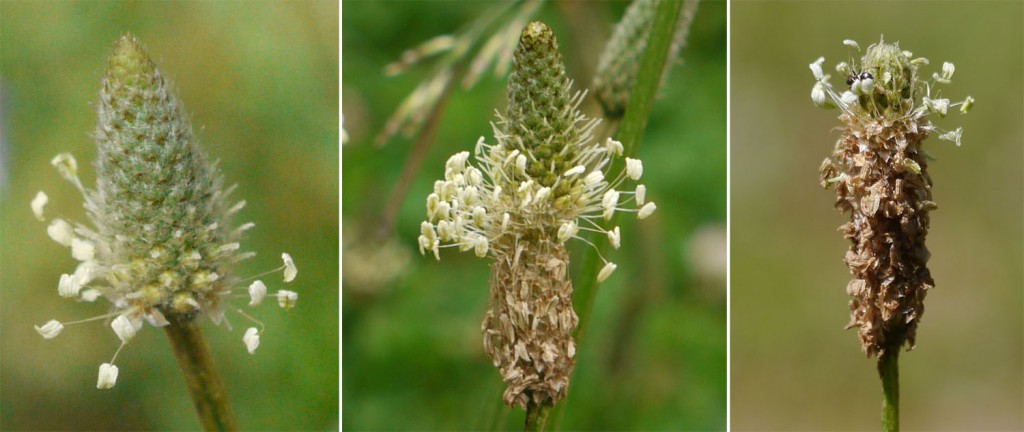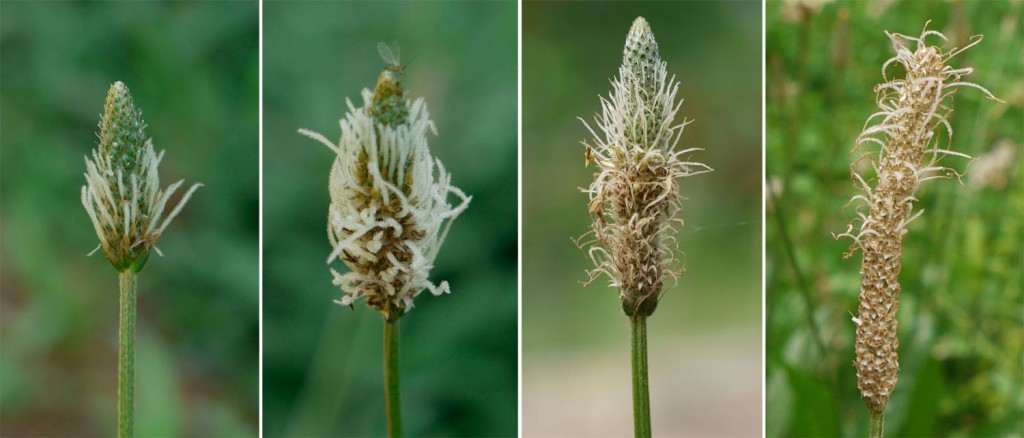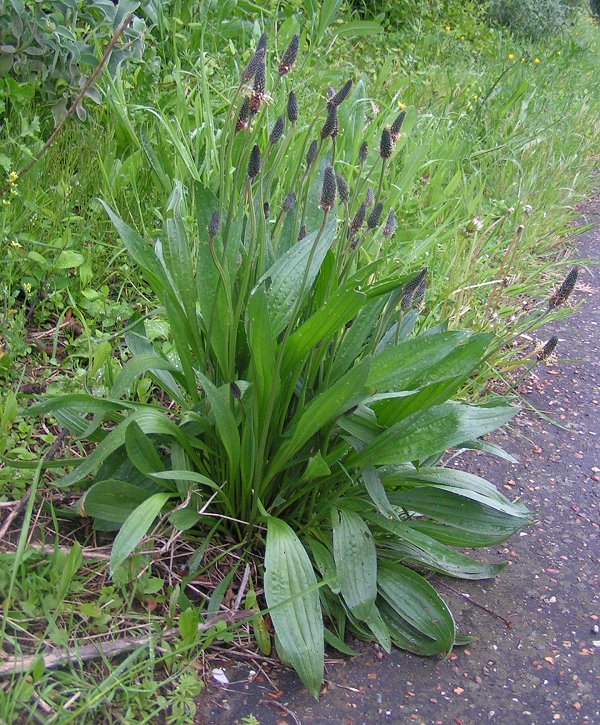Plantain is generally considered to be a weed; one description, referring to Plantago major, even reads ‘a short, fat, ugly weed’!! But beauty is in the eye of the beholder.
Plantain has a long history as one of the best healing herbs on the planet and is probably the biggest masochist of the plant world. It loves to be trampled.
Plantains leaves have been used for centuries all over the world as a remedy for wounds, bites, stings and problems related to the skin.
Whilst there are many, many plantains (all in the same family Plantaginaceae), it is the greater plantain (Plantago major) and the Ribwort (Narrowleaf or English) Plantain (Plantago lanceolata) that have the most effective active ingredients.
Whilst Greater Plantain has fat, oval shaped leaves, Ribwort has narrower lance shaped leaves. Both leaves have the characteristic parallel veins, more noticeable and raised on the underside of the leaf.

Ribwort Plantain
Latin Name: Plantago lanceolata
Plant Family: Plantaginaceae
Common names: ribwort plantain, narrowleaf plantain, English plantain, ribleaf, lamb’s tongue, and buckhorn.
Ribwort plantain is a plant of grasslands, field edges and cultivated ground and tracks, and regularly pops up in lawns as a weed. It flowers between April and October; in contrast to the long flower spikes of greater plantain, the short, oval flower heads of ribwort plantain appear as if balanced on the top of their thin, wiry stems. Its seed heads remain for most of the winter providing food for goldfinches and other seed-eating birds.
Greater Plantain
Latin Name: Plantago major syn. Plantago borysthenica, Plantago dregeana, Plantago latifolia, Plantago sinuata.
Plant Family: Plantaginaceae
Common Names: Common Plantain, Greater Plantain, Broadleaf Plantain, Way Bread, Snake Weed, Ripple Grass, Slanlus. Waybroad, Cuckoo’s Bread, Englishman’s Foot, White Man’s Foot, Che Qian Zi, Weybroed, Wegerich, Piantaggine & Plâtano.
Greater Plantain is a low to short perennial herb found on grassy, open waste & disturbed habitats such as trampled paths and tracks, field edges, roadsides, gardens, lawns and meadows. It grows in a wide range of soils (except highly acidic soils) and ‘can produce a large and persistent seed bank’1.
Both have flowers that mature from the bottom to the top, so the bottom can show brown, whilst the middle shows white and the top still developing. The left 3 images show male flowers, whilst the right 4 are female flowers. The short oval heads are Ribwort Plantain and the long flower spikes are Greater Plantain.


History & Folklore
Plantain is another of the ancient Saxons ‘Nine Sacred Herbs’. It is believed that the ‘waybread’ (Wegbrade) in the Nine Herbs Charm is Plantain. Although this seems to have been due to its medicinal properties rather than its magical.
Plantain seed is often found in grain seeds and it is thought that this is how the herb spread across the world. It was called “White man’s footprint” by Native Americans because it sprouted up wherever European settlers had spent any amount of time. The classic Latin name Plantago was formed from the Latin word ‘Planta‘ meaning the ‘sole of the foot’
It was also called “Soldier’s herb” due to its use as a field dressing.
In Devon it was often referred to as ‘Cuckoo Bread’ and it was believed that once, every seven years it changed into a cuckoo and flew away.
It was believed to be a protective plant being hung in the home for this purpose or carried to protect against the dangers of travel such as snake-bites. In Ireland it is associated with St. Patrick who is also associated with ‘averting snakes’.
Used since prehistoric times, it is referenced many times from the Anglo-Saxons to Chaucer and Shakespeare.
Traditional Uses & Benefits of Plantain
Plantains leaves have been used for centuries all over the world as a remedy for wounds and a number of problems related to the skin, respiratory organs, digestive organs, reproductive organs and circulatory system. Both the Greater Plantain & the Ribwort Plantain have these properties. However the Greater Plantain is also edible; use the tender young leaves in salads and the older larger leaves cooked (as you would spinach), all parts of Greater Plantain are edible including the seeds.
A range of biological activities has been found from plant extracts including wound healing activity, anti-inflammatory, analgesic, antioxidant, weak antibiotic, immuno modulating and antiulcerogenic activity. Some of these effects may attribute to the use of this plant in folk medicine2.
- Plantain is very high in vitamins A and C and in calcium.
- The leaves are a traditional remedy (originally chewed) for bee stings & insect bites, the itching of nettle stings, allergic rashes and minor burns, cuts and sores.
- The leaves can be used to make a salve for the above purposes.
- New young leaves can be used raw in salads and cooked as ‘greens’.
- Older leaves can be used to make a tea/tissane which due to Plantains astringent properties can aid colds and diarrhea.
- Plantain tea can also be used as a mouthwash for sore gums, throats and mouth ulcers.
- A Plantain tea can also be used for washing the skin, hair and scalp where ‘itchy or sore’ conditions exist.
Plantain is listed as having the following Properties:
- Antibacterial: – destroys or suppresses the growth of bacteria
- Antimicrobial: – destroys or stops the growth of microorganisms
- Anti-inflammatory: – reduces inflammation
- Anti-toxic: – counteracts toxins
- Vulnerary: – of use in the healing of wounds
- Astringent: – encourages skin cells to contract
Cautions
Although there are no known cautions for this herb as with anything care should be taken as it possible to be allergic to any substance.
You can purchase Plantain at The Herbal Apothecary.
- Blamey and Grey-Wilson 2003, Online Atlas of the British and Irish Flora 2012, Castroviejo et al. 2009.
- (Samuelsen 2000) https://www.ncbi.nlm.nih.gov/pubmed/10904143 .

Very interesting. I have a mouth ulcer at the moment. Today on a dog walk I chewed some leaves I found from the Ribwort Plantain and left them against the ulcer. How back at home I am making a Ribwort tea to test as a mouthwash. Will be interesting to see if it makes a difference.